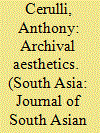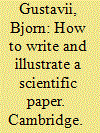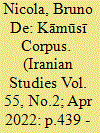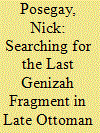|
|
|
Sort Order |
|
|
|
Items / Page
|
|
|
|
|
|
|
| Srl | Item |
| 1 |
ID:
172224


|
|
|
|
|
| Summary/Abstract |
Can the Indian manuscript and manuscript library be art? In what follows, I reflect on this question by examining a set of photographs I created for an art project called Manuscriptistan. I explain what it has meant for me to aestheticise Indian manuscript libraries and manuscripts, and I offer some insights about why it is important for scholars to bring sensual, spatial and artistic awareness to the things with which, and the spaces in which, they do their research.
|
|
|
|
|
|
|
|
|
|
|
|
|
|
|
|
| 2 |
ID:
050772


|
|
|
|
|
| Publication |
Cambridge, Cambridge University Press, 2003.
|
| Description |
ix, 141p.Pbk
|
| Standard Number |
0521530245
|
|
|
|
|
|
|
|
|
|
|
|
Copies: C:1/I:0,R:0,Q:0
Circulation
| Accession# | Call# | Current Location | Status | Policy | Location |
| 047849 | 808.0665/GUS 047849 | Main | On Shelf | General | |
|
|
|
|
| 3 |
ID:
184811


|
|
|
|
|
| Summary/Abstract |
The arrival of the Mongols in Iran in the thirteenth century made a deep impact on the political, economic, and religious life of the region. With the establishment of the Ilkhanate (1250–1335), the cultural life of Iran was also transformed. The territories under Mongol control saw the appearance of new architectural styles, a renaissance of Persian literature, and a burst in the production of Islamic manuscripts. Regarding this literary production, scholars have concentrated their efforts on studying important works composed in Mongol Iran either for their scientific, literary, or artistic value. However, most of this research focuses on individual manuscripts or specific works belonging to a concrete literary genre; these do not provide a holistic picture of the production, distribution, and consumption of the huge number of manuscripts surviving from the period. In an attempt to contribute to a more comprehensive understanding of this phenomenon, this study looks at six different manuscripts, jointly referred to as the “Kāmūsī corpus,” that share the rare characteristic of having all been copied by the same hand in fourteenth-century Iran. This article investigates the individuals involved in the production of these manuscripts, identifies the different works included in this corpus, and connects the production of these texts and the dissemination of knowledge in Ilkhanid Iran.
|
|
|
|
|
|
|
|
|
|
|
|
|
|
|
|
| 4 |
ID:
188161


|
|
|
|
|
| Summary/Abstract |
The Cairo Genizah is well known as a repository for hundreds of thousands of manuscripts that the Jewish residents of Fustat (Old Cairo) produced and consumed in the premodern period. Foreign “collectors” acquired most of these manuscripts for European libraries in the second half of the nineteenth century, with the majority arriving at the Cambridge University Library in 1897 under the auspices of Solomon Schechter. Less well known is the fact that hundreds of Genizah fragments were produced in the late nineteenth century, even as European collectors were scouring Cairo for ancient texts. This later corpus includes witnesses to the social and economic history of late Ottoman Cairo and provides copious evidence for the material history of Egyptian Jewish literary activity at that time. Despite this, it remains understudied for both Ottoman and Jewish history. Late Genizah material also raises questions about the integrity of “Cairo Genizah” manuscript collections around the world, as some fragments postdate Schechter's Genizah “discovery,” and others were never in Egypt at all.
|
|
|
|
|
|
|
|
|
|
|
|
|
|
|
|
|
|
|
|
|